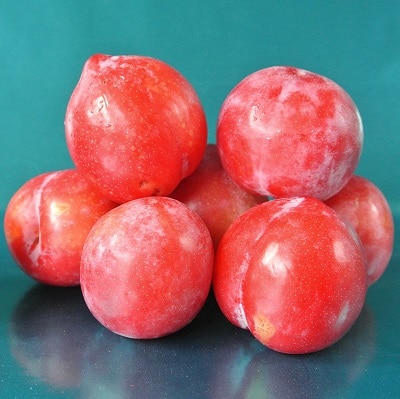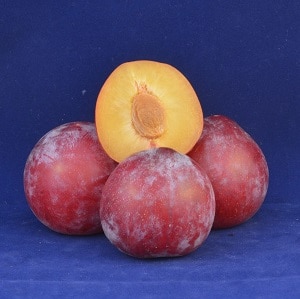Laetitia is a bright red Japanese-type plum with a yellowish background skin colour, often with numerous white lenticel spots. The shape is round-oblong, often with a characteristic point at the stylar-end. The flesh is dark yellow to light orange and has a melting, juicy texture. Unlike many other plums, Laetitia has already developed a good flavour at the picking-ripe stage, and when eating-ripe has a pleasant, sweet taste with a good aroma.
Laetitia is a late mid-season plum.
Growers are attracted to Laetitia as it fills a gap between Harry Pickstone and Songold; can be exported by sea at the normal dual temperature regime (-0.5 C. for 10 days, 7.2° C. for 14 days); and is highly resistant to Bacterial Spot and other leaf diseases.
Good Fruit Guide Rating: ****
Consumers will be pleased with Laetitia for its sweetness and flavour, but also its reliability in ripening in the fruit bowl.
Sweet, juicy, reliable.
Names: Laetitia
Origin: Laetitia was discovered as an open-pollinated seed of Golden King with a potential pollen parent of either Santa Rosa, Gaviota or Red Ace. The seed was collected in 1972 and the resultant trees bore their first fruit in 1977, being evaluated in Franschhoek, Stellenbosch and Groot Drakenstein, South Africa by Chris Smith of Stellenbosch. The variety was released in 1985 by ARC Infruitec, Nietvoorbij, South Africa.
Grown in: South Africa, Israel, Spain
Harvest & Availability: Harvesting of Laetitia in Bien Donne, South Africa generally takes place in the third week of January; 8-10 days prior to Songold. Availability in UK is as follows:
- January:
- February: South Africa
- March: South Africa
- April:
- May:
- June:
- July:
- August:
- September:
- October:
- November:
- December:
Websites:



